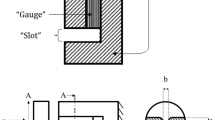Abstract
Recent activities by the present investigators to further develop the losipescu-shear-test method for use with composite materials are summarized. Finite-element analyses used to predict the stress states in the specimen are described, with particular emphasis on how they are influenced by the specific test-fixture configuration used. These same analytical tools were also used to predict the influence of specimen notch depth, notch angle, and notch-root radius. The result was a redesign of the original Wyoming version of the losipescu-shear-test fixture, and the establishment of guidelines for preparing specimens. These are discussed in some detail. Many references to available literature are included. An attempt has been made to put the work performed to date into perspective, to aid the potential user of the losipescu-shear-test method in establishing proper test procedures.
Similar content being viewed by others
References
Iosipescu, N., “New Accurate Procedure for Single Shear Testing of Metals,”J. Mat.,2 (3),537–566 (Sept. 1967).
Walrath, D.E. andAdams, D.F., “The Iosipescu Shear Test as Applied to Composite Materials,”Experimental Mechanics,23 (1),105–110 (March 1983).
Adams, D.F. and Walrath, D.E., “Iosipescu Shear Properties of SMC Composite Materials,” Composite Materials: Testing and Design (6th Conf.), ASTM STP 787, 19–33 (1982).
Lee, S. andMunro, M., “In-plane Shear Properties of Graphite Fiber/Epoxy Composites for Aerospace Applications: Evaluation of Test Methods by the Decision Analysis Technique,”Aero. Note NAE-AS22, NRC No. 23778, Mechanical Engineering Dept., Univ. of Ottawa, Ottawa, Canada (Oct. 1984).
Spigel, B.S., “An Experimental and Analytical Investigation of the Iosipescu Shear Test for Composite Materials,” MS Thesis, Old Dominion Univ. (Aug. 1984).
Walrath, D.E. and Adams, D.F., “Analysis of the Stress State in an Iosipescu Shear Test Specimen,” Rep. No. UWME-DR-301-102-1, Dept. of Mechanical Engineering, Univ. of Wyoming, NASA Grant No. NAG-1-272 (June 1983). Also available as NASA-CR-176745.
Walrath, D.E. and Adams, D.F., “Verification and Application of the Iosipescu Shear Test Method,” Rep. No. UWME-DR-401-103-1, Dept. of Mechanical Engineering, Univ. of Wyoming, NASA Grant No. NAG-1-272 (June 1984). Also available as NASA-CR-174346.
Walrath, D.E. and Adams, D.F., “Iosipescu Shear Properties of Graphite Fabric/Epoxy Composite Laminates,” Rep. No. UWME-DR-501-103-1, Dept. of Mechanical Engineering, Univ. of Wyoming, NASA Grant No. NAG-1-272, (June 1985). Also available as NASA-CR-176316.
Walrath, D.E. and Adams, D.F., “Damage Mechanisms/Failure Mechanics of Carbon-Carbon Composite Materials,” Rep. No. UWME-DR-904-101-1, Dept. of Mechanical Engineering, Univ. of Wyoming (1979). Also available as AD-A090571.
Herakovich, C.T. and Bergner, H.W., Jr., “Finite Element Stress Analysis of a Notched Coupon Specimen for In-plane Shear Behavior of Composites,” Composites, 149–154 (July 1980).
Marloff, R.H., “Finite Element Analysis of Biaxial Stress Test Specimen for Graphite/Epoxy and Glass Fabric/Epoxy Composites,” Composite Materials: Testing and Design (6th Conf.), ASTM STP 787, 34–49 (1982).
Author information
Authors and Affiliations
Rights and permissions
About this article
Cite this article
Adams, D.F., Walrath, D.E. Further development of the losipescu shear test method. Experimental Mechanics 27, 113–119 (1987). https://doi.org/10.1007/BF02319461
Received:
Revised:
Issue Date:
DOI: https://doi.org/10.1007/BF02319461




